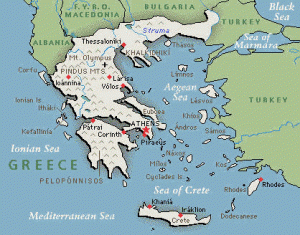This is being posted on Friday, September 13; there will be another Friday the 13th in December.
Friday the 13th (F13) gets a bad rap. Believed by some to be the unluckiest day of the year, many people fear it – probably because both Friday, the day of the week, and the number 13 are considered to be unlucky or negative in our modern cultures. This was not always the case, and we do not have to be trapped in negativity if we reach way back – as we have in earlier posts – to a time that was ruled by female deities.
The English word “Friday” derives from the Norse goddess Freya (or Frigg) who was worshiped on the Sixth Day. As the goddess of marriage, sex and fertility, Freya/Frigg corresponds to the Roman goddess Venus, the goddess of love.
There are several theories for the derivation of the unluckiness of the number 13. In Viking lore, the myth has to do with the trickster god Loki. A dinner for 12 guests was held in Valhalla, but Loki crashed it and tricked another attendee into killing the god Baldur. Similarly, Jesus’ Last Supper included the 12 disciples, but one of those 13 men was Judas, the one who betrayed Jesus and sent him to his death. Finally, where the number 12 is considered complete – as in the 12 tribes of Israel, the 12 disciples, the number of months in the year, and the number of gods on Olympus and signs of the zodiac – the number 13 offsets this completeness. The fear of the number 13 has a name: triskaidekaphobia, from the Greek triskaídeka, “thirteen.”
 Dr. Donald Dossey, a phobia specialist, has coined the term “paraskevidekatriaphobia” to designate the fear of F13; Dr. Dossey maintains that this is the most widespread superstition in the US, which can have economic and other negative consequences. Where does Dr. Dossey’s term come from? There is yet another Greek association: Paraskevi is Greek for “Friday” as well as the name of a saint and martyr. According to her hagiography, Paraskevi/Paraskeva, venerated widely by Orthodox Christians even today, was born on a Friday to righteous Christian parents. She led a devout Christian life, but during the reign of the Emperor Antoninus Pius (138-161 CE), she was arrested and urged to worship Graeco-Roman deities. She refused, was tortured, and was ultimately beheaded under Antoninus’ successor, Marcus Aurelius, in 140 CE.
Dr. Donald Dossey, a phobia specialist, has coined the term “paraskevidekatriaphobia” to designate the fear of F13; Dr. Dossey maintains that this is the most widespread superstition in the US, which can have economic and other negative consequences. Where does Dr. Dossey’s term come from? There is yet another Greek association: Paraskevi is Greek for “Friday” as well as the name of a saint and martyr. According to her hagiography, Paraskevi/Paraskeva, venerated widely by Orthodox Christians even today, was born on a Friday to righteous Christian parents. She led a devout Christian life, but during the reign of the Emperor Antoninus Pius (138-161 CE), she was arrested and urged to worship Graeco-Roman deities. She refused, was tortured, and was ultimately beheaded under Antoninus’ successor, Marcus Aurelius, in 140 CE.
The negative associations of F13 include the following biblical examples:
- It was presumably on a Friday that “Eve tempted Adam with the apple, thus banishing mankind from Paradise.” [Genesis 2:4-3:24]
- “The Great Flood [Genesis 6:9-9:17] began on a Friday.”
- “The Temple of Solomon was destroyed [2 Kings 25:8-17] on a Friday.”

- Jesus’ crucifixion took place on a Friday (hence, “Good Friday”).
In addition, in ancient Rome and Britain, Friday was known as “hangman’s day,” the day that condemned people would be hanged.
However, as we have begun to see in the examples of Freya/Frigg and Venus, neither Friday nor the number 13 has always had negative, unlucky or fearsome connotations. Freya/Frigg and Venus are only two of the myriad examples of other symbols and practices, inherited by the West over millennia, that once belonged to goddesses and the female side of life.
- The lunar calendar, which is still observed in Judaism, Islam, and Hinduism, has 13 months. Very ancient, this derives from the female menstrual cycle, which is approximately 28 days (thus, 13 months times 28 days = 364 days). The solar calendar, which may have originated in Egypt and was ultimately adopted as the Julian calendar in 45 BCE, has 12 months. Thus the patriarchal system, which emerged centuries later than the female-oriented system, triumphed over the 13-month lunar calendar – and of course necessitates complicated “correction” measures to have the year match up correctly with the seasons. In the solar calendar, some of our 12 months have 30 days, some have 31 and February has 28 – and that still requires correction by intercalation.
 The Romans named the sixth day of the week in love goddess Venus’ honor “dies Veneris.” Love is a positive!
The Romans named the sixth day of the week in love goddess Venus’ honor “dies Veneris.” Love is a positive!- Friday was considered to be a lucky day by Norse and Teutonic peoples – especially as a day to get married – because of its traditional association with love and fertility.
- St. Lucia, a Christian martyr who was killed by the Romans in 304 CE, is celebrated in Sweden and Norway on December 13th with festivals of lights (Sjöö and Mor, 156-57). The modern rites incorporate both Graeco-Roman and Christian elements.
- The Greek god Hecate is celebrated on August 13th (Sjöö and Mor, 157). Hecate came to have negative associations as a deity of the underworld, who was associated with death, and who killed newborns. But she was also a powerful deity, similar to Athena, who was wise, provided power to warriors, and who “brought inspiration and victory to the Greek soldiers.” Like other goddesses of regeneration, dating from Neolithic times, Hecate nurtured human beings, even being referred to as “a nurse of the young” by the poet Hesiod (Dexter, 125). Hecate gave life and also took it away.
- There are 13 members in a witch’s coven (Sjöö and Mor, 157). In our culture, witches have traditionally been associated with ugliness, making pacts with the devil, possessing evil supernatural powers, destroying crops, eating children, and the witch trials throughout Europe and the US. However, witches’ ancestry is more positive. The large wings of vultures, for instance, which ultimately evolved into the witch’s broom in European folklore, originally symbolized the power and energy of the Death Goddess (Gimbutas, 189). This deity is the Goddess of Death and Regeneration, a seer full of wisdom who kills within the cycle of life, reminding “us that nature is mortal and that there is no life without death” (Gimbutas, 210). It is a great distortion to transform this figure into the Wicked Witch of the West.
- Even today in some European folk beliefs, including St. Brigit in Ireland, there are positive connections to Friday and St. Paraskevi/Paraskeva.
 Friday being the special day of the prehistoric goddess, people would refrain from any work involving turning, twisting or spinning, all connected with the “women’s work” of weaving (Gimbutas, 68). Relatedly, the St. Friday revered in Russia was the “patroness of healing springs … where the paralyzed, the blind, and the deaf offered flax, wool, and sheep” (Gimbutas, 110). Eyesight is also involved with St. Paraskevi/Paraskeva in Greece: her July 26th feast day “is an especially good time for curing eye diseases” (Gimbutas, 61). The Slavic version of this saint is “the dispenser of the water of life and the spinner of the thread of life” (Gimbutas, 311). All of these have positive, female-themed associations.
Friday being the special day of the prehistoric goddess, people would refrain from any work involving turning, twisting or spinning, all connected with the “women’s work” of weaving (Gimbutas, 68). Relatedly, the St. Friday revered in Russia was the “patroness of healing springs … where the paralyzed, the blind, and the deaf offered flax, wool, and sheep” (Gimbutas, 110). Eyesight is also involved with St. Paraskevi/Paraskeva in Greece: her July 26th feast day “is an especially good time for curing eye diseases” (Gimbutas, 61). The Slavic version of this saint is “the dispenser of the water of life and the spinner of the thread of life” (Gimbutas, 311). All of these have positive, female-themed associations.
What this boils down to is that the day Friday and the number 13 both had positive connotations in societies with strong female associations, going back millennia. However, under the influence of the worst impulses of Christianity and western civilization, they came to be viewed negatively. When the 13th of the month also falls on a Friday, which should in goddess-speak be celebrated and for which we should ponder life, love, birth, and nurturing, the day has come to have opposite associations. The (mostly male) leaders of the church – following on the heels of the male-dominated monolithic religions – were compelled to replace almost anything that honored women and the female side of life with male principles and associations. So, by the Middle Ages, “the Church went to great lengths to disassociate itself with Friday and thirteen. If Friday was a holy day for heathens, the Church fathers felt, it must not be so for Christians – thus it became known in the Middle Ages as the ‘Witches’ Sabbath’.”
There is much positive to say about Christianity, Christians, church leaders, Christian values, Christian art and music, church communities, and so on. Allowing Christianity to make Friday the 13th a day of fear and negativity is not one of them. Let us reclaim the ancient, goddess-related associations with this very special day!
Resources
Dexter, Miriam Robbins. Whence the Goddesses: A Source Book. The Athene Series. New York: Pergamon Press, 1990.
Gimbutas, Marija. The Language of the Goddess. New York: HarperSanFrancisco, 1991.
Sjöö, Monica and Barbara Mor, The Great Cosmic Mother. San Francisco: Harper & Row, Publishers, 1987.
